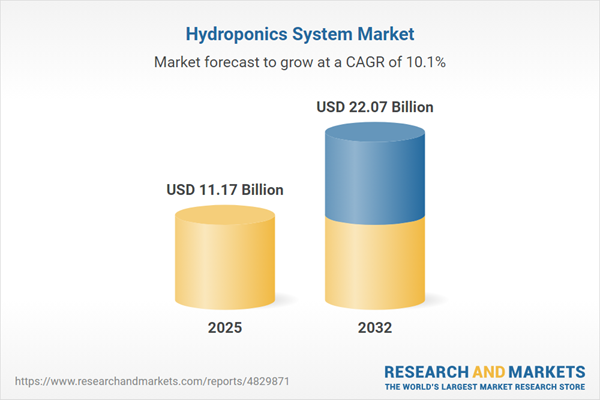Speak directly to the analyst to clarify any post sales queries you may have.
Hydroponics systems are rapidly redefining food production, enabling efficient, soil-less cultivation that aligns with sustainability goals and resource constraints. As organizations and producers worldwide prioritize reliable yields and reduced ecological impact, hydroponics technology stands out for offering adaptive solutions across both traditional and emerging market contexts.
Hydroponics System Market Snapshot
The hydroponics system market grew from USD 10.20 billion in 2024 to USD 11.17 billion in 2025. It is projected to maintain robust expansion at a CAGR of 10.13%, reaching USD 22.07 billion by 2032. Market growth is propelled by increasing demand for sustainable farming methods, technological advancements driving operational efficiency, and strategic shifts in global supply chains shaped by regulatory factors and evolving consumer expectations.
Scope & Segmentation of the Hydroponics System Market
This analysis provides a comprehensive assessment of market drivers, segmentation, and technological innovations relevant to senior decision-makers. The study explores all critical dimensions impacting hydroponics adoption and success across regions and end-use segments.
- Component – Environmental control systems (HVAC, irrigation systems, LED grow light, material handling), growing medium options (coco fiber, perlite & vermiculite, rockwool), and nutrient solutions are integral for precision management of hydroponic operations.
- System Type – Aggregate systems (ebb & flow, wick system) and liquid systems (aeroponics, deep water culture, drip system, nutrient film technique) enable varied approaches, each with distinct implications for yield, scalability, and operational complexity.
- Crop Type – Market is shaped by cultivation of flowers, fruits, herbs, and vegetables, allowing tailored solutions for unique agronomic requirements.
- Crop Area – Facilities range from compact urban installations (up to 1,000 sq.ft.) to large commercial sites (above 50,000 sq.ft.), supporting diverse deployment and business models.
- Application – Commercial farming, institutional or research purposes, and residential or urban farming each drive innovation and service model differentiation.
- Geography – Regional coverage spans the Americas (North America: United States, Canada, Mexico; Latin America: Brazil, Argentina, Chile, Colombia, Peru), Europe/Middle East/Africa (including United Kingdom, Germany, France, United Arab Emirates, South Africa, and others), and Asia-Pacific (China, India, Japan, Australia, South Korea, among others).
- Industry Players – In-depth analysis of leading and emerging providers including Agromatic Corporation, Alien Hydroponics by Black Dog Horticulture Technologies & Consulting, American Hydroponics, Arable, Atlas Scientific, Avisomo AS, Babylon Micro-Farms, CropKing, CubicFarm Systems, Denso Corporation, Freight Farms, Greentech Organic Hydroponics Systems Mfrs., HydroGarden Limited, IntelliPonics, and ZipGrow Inc.
Key Takeaways for Senior Decision-Makers
- Investment in digital integration and automation is accelerating operational efficiencies and supporting consistent quality in crop production.
- Adaptability to fluctuating supply chain conditions—shaped by trade regulations and tariff adjustments—is critical for maintaining cost competitiveness.
- Environmental stewardship and resource savings, including water recirculation and closed-loop nutrient recovery, drive adoption and are increasingly integrated as core performance metrics.
- Technological innovation in areas such as LED lighting, IoT-enabled monitoring, and advanced substrates enables year-round and location-flexible cultivation.
- Regional dynamics require market participants to align solutions with local regulatory, economic, and infrastructural environments to maximize adoption and return on investment.
Tariff Impact
The introduction of new United States tariffs in 2025 has altered the cost landscape for hydroponics, affecting not only imported components but also the sourcing strategies of manufacturers and growers. As a result, enterprises are proactively diversifying supplier portfolios, developing nearshore manufacturing partnerships, and internalizing key production capacities. These shifts have spurred innovation in supply chain management, strengthening business resilience while encouraging strategic stockpiling and localized production to minimize exposure to trade volatility.
Methodology & Data Sources
This report draws on a structured mixed-methods approach, combining primary interviews with industry leaders, supplier insights, and analyst roundtables, with secondary research from proprietary databases, peer-reviewed journals, and regulatory documentation. Data accuracy is ensured through triangulation and scenario analysis, providing reliable perspectives for strategic planning.
Why This Hydroponics System Market Report Matters
- Delivers actionable intelligence for technology selection, capital allocation, and supplier engagement decisions supporting scale, agility, and sustainability objectives.
- Enables thorough assessment of regional, segment-specific, and regulatory drivers influencing market entry, innovation roadmaps, and partnership strategies.
Conclusion
Hydroponics continues to redefine agricultural productivity and sustainability, with resilient supply strategies and focused technological innovation supporting global expansion. This analysis offers actionable, evidence-based perspectives to guide confident decision-making across diverse market segments.
Additional Product Information:
- Purchase of this report includes 1 year online access with quarterly updates.
- This report can be updated on request. Please contact our Customer Experience team using the Ask a Question widget on our website.
Table of Contents
3. Executive Summary
4. Market Overview
7. Cumulative Impact of Artificial Intelligence 2025
Companies Mentioned
The companies profiled in this Hydroponics System market report include:- Agromatic Corporation Pty Ltd
- Alien Hydroponics by Black Dog Horticulture Technologies & Consulting
- American Hydroponics, Inc.
- Arable
- Atlas Scientific, LLC
- Avisomo AS.
- Babylon Micro-Farms Inc.
- CropKing Incorporated
- Croppico LLP
- CubicFarm Systems Corp.
- Denso Corporation
- Eden Grow Systems Inc.
- Engineering Services & Products Company.
- Freight Farms, Inc.
- Greentech Organic Hydroponics Systems Mfrs.
- GROWRILLA SRLS
- Harvester Horticulture Products
- Hawthorne Gardening Company by The Scotts Company LLC
- Heliospectra AB
- Hydra Unlimited by Flow-Rite Controls
- Hydrofarm Holdings Group, Inc.
- HydroGarden Limited
- JH Hydroponic Systems, S.L.
- NEW GROWING SYSTEM S.L.
- NuLeaf Farms Inc.
- Ponix, Inc
- Signify N.V.
- Tower Garden, LLC
- Urban Crop Solutions BV
- Verdant Farms & Developers Private Limited.
- WE Hydroponics
- ZipGrow Inc.
Table Information
| Report Attribute | Details |
|---|---|
| No. of Pages | 187 |
| Published | November 2025 |
| Forecast Period | 2025 - 2032 |
| Estimated Market Value ( USD | $ 11.17 Billion |
| Forecasted Market Value ( USD | $ 22.07 Billion |
| Compound Annual Growth Rate | 10.1% |
| Regions Covered | Global |
| No. of Companies Mentioned | 33 |









